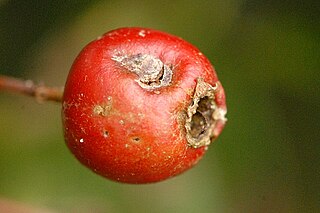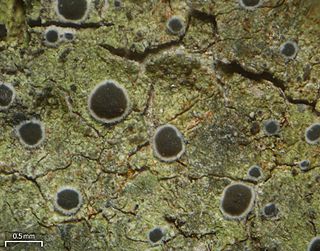
Komagataella is a methylotrophic yeast within the order Saccharomycetales. It was found in the 1960s as Pichia pastoris, with its feature of using methanol as a source of carbon and energy. In 1995, P. pastoris was reassigned into the sole representative of genus Komagataella, becoming Komagataella pastoris. Later studies have further distinguished new species in this genus, resulting in a total of 7 recognized species. It is not uncommon to see the old name still in use, as of 2023; in less formal use, the yeast may confusingly be referred to as pichia.

Sordariomycetes is a class of fungi in the subdivision Pezizomycotina (Ascomycota). It is the second-largest class of Ascomycota, with a worldwide distribution that mostly accommodates terrestrial based taxa, although several can also be found in aquatic habitats. Some are phytopathogens that can cause leaf, stem, and root diseases in a wide variety of hosts, while other genera can cause diseases in arthropods and mammals.

Saccharomycetales belongs to the kingdom of Fungi and the division Ascomycota. It is the only order in the class Saccharomycetes. There are currently 13 families recognized as belonging to Saccharomycetales. GBIF also includes; Alloascoideaceae, Eremotheciaceae (16) Trigonopsidaceae and Wickerhamomycetaceae.

Pichia is a genus of yeasts in the family Pichiaceae with spherical, elliptical, or oblong acuminate cells. Pichia is a teleomorph, and forms hat-shaped, hemispherical, or round ascospores during sexual reproduction. The anamorphs of some Pichia species are Candida species. The asexual reproduction is by multilateral budding.

The Venturiaceae are a family of fungi in the order Venturiales. Several of the species in this family are plant pathogens.

Pleosporaceae is a family of sac fungi. They are pathogenic to humans or saprobic on woody and dead herbaceous stems or leaves.

The Pilocarpaceae are a family of crustose lichens in the order Lecanorales. The species of this family have a cosmopolitan distribution and have been found in a variety of climatic regions. Pilocarpaceae was circumscribed by Alexander Zahlbruckner in Adolf Engler's influential 1905 work Die Natürlichen Pflanzenfamilien.
Geminispora is a genus of fungi in the family Phyllachoraceae; according to the 2007 Outline of Ascomycota, the placement in this family is uncertain.
Ophiodothella is a genus of fungi in the family Phyllachoraceae.
The Ascoideaceae are a family of yeasts in the order Saccharomycetales. It contains the two genera Ascoidea and Alloascoidea. Species in the family have a widespread distribution, and typically grow in beetle galleries in dead wood.

The Dipodascaceae are a family of yeasts in the order Saccharomycetales. According to the 2007 Outline of Ascomycota, the family contains four genera; however, the placement of Sporopachydermia and Yarrowia is uncertain. GBIF accepted all the species and also added Magnusiomyces' and Protendomycopsis to the family. Species in the family have a widespread distribution, and are found in decaying plant tissue, or as spoilage organisms in the food industry.

The Ophiostomataceae are a family of fungi in the Ascomycota, class Sordariomycetes. The family was circumscribed by J.A. Nannfeldt in 1932. Species in the family have a widespread distribution, and are typically found in temperate regions, as pathogens of both coniferous and deciduous trees.

The Capnodiaceae are a family of fungi in the Ascomycota, class Dothideomycetes. Species in the family have a widespread distribution, and are especially prevalent in tropical and subtropical areas, as well as temperate rainforests.
Nakazawaea is a genus of yeast in the order Saccharomycetales. The relationship of this taxon to other taxa within the order is not fully unknown.
Phaffomyces is a genus of fungi within the Saccharomycetales order. It is placed within the Pichiaceae fungi family.
Starmera is a genus of fungi within the Saccharomycetales order. It is placed within the Phaffomycetaceae family.
Kuraishia is a genus of two species of ascomycetous yeasts in the family Saccharomycetaceae. The type species Kuraishia capsulata was originally described as a member of Hansenula in 1953.

Ogataea is a genus of ascomycetous yeasts in the family Saccharomycetaceae. It was separated from the former genus Hansenula via an examination of their 18S and 26S rRNA partial base sequencings by Yamada et al. 1994.
The Phaffomycetaceae are a family of yeasts in the order Saccharomycetales that reproduce by budding. Species in the family have a widespread distribution.
Helocarpaceae is a family of lichen-forming fungi in the subclass Lecanoromycetidae. The family is monotypic, and contains the single genus Helocarpon.











